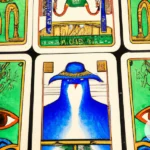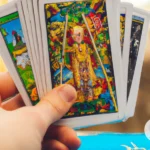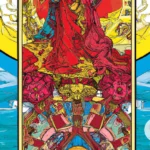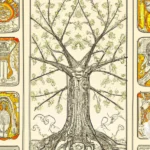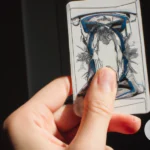Introduction: Understanding the Court Cards
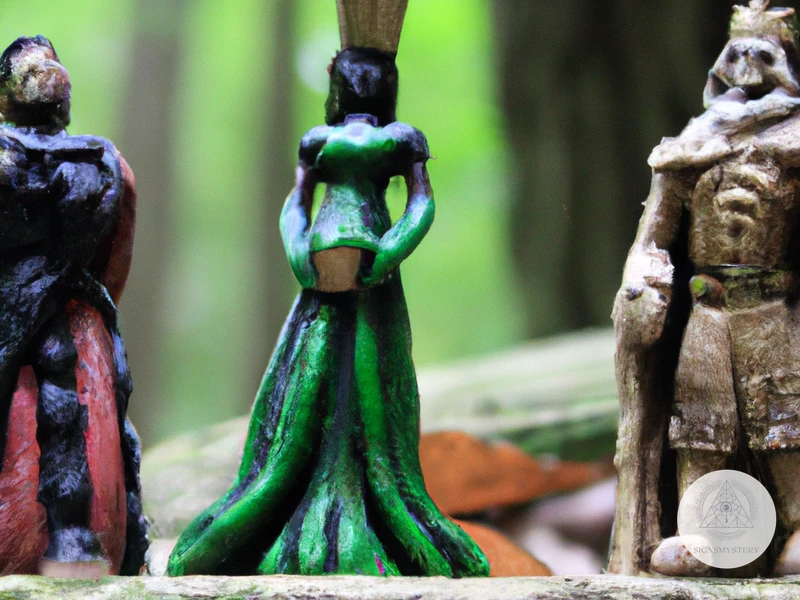
The Tarot is a centuries-old divination tool that offers insight into the human experience. Consisting of two distinct parts, the Major Arcana and Minor Arcana, Tarot cards provide guidance on various aspects of life, from love and relationships to career and spirituality. Within the Minor Arcana, there are 56 cards divided into four suits, each representing a different element and corresponding to a specific area of life. The Court Cards, a subcategory of the Minor Arcana, are crucial to understanding the complexities of the Tarot.
Unlike the numbered cards in the Minor Arcana, the Court Cards each depict a distinct character, making them resemble characters in a traditional deck of playing cards. The Court Cards consist of Pages, Knights, Queens, and Kings, each representing different archetypes and characteristics. These cards can have a significant impact on the outcome of a reading and help offer additional layers of insight to a Tarot spread.
The Court Cards can be challenging to interpret due to their complexity and the many meanings attributed to each one. Understanding the Court Cards is crucial, however, as they can provide valuable insights into the querent’s situation. They can also reveal hidden information about relationships, emotional states, and power dynamics.
Throughout this article, we will explore the Court Cards in detail, examining the symbolism and meanings attributed to each. Additionally, we will discuss how to read these cards in conjunction with other cards in a spread, offer tips for working with Court Cards, and explore the relationships between these cards. Understanding the Court Cards is essential for any Tarot practitioner, and we hope this article will provide you with the tools and knowledge needed to gain greater insight into their meanings.
The Minor Arcana: An Overview
The Minor Arcana is the lesser-known counterpart of the Major Arcana in the Tarot deck. It consists of four suits, namely Pentacles, Swords, Cups, and Wands, each comprising ten numbered cards and four court cards. These cards focus on the less profound aspects of life, including our everyday struggles, mundane events, and ordinary challenges. While the Major Arcana represents significant events and major life changes, the Minor Arcana deals with the minute details that contribute to our overall experiences. Each suit has its unique theme and symbolizes specific areas of life. The Pentacles represent finances, the Swords indicate mental processes, the Cups signify emotions, and the Wands depict creativity and passion. Understanding the Minor Arcana is vital as it adds depth and insight into our daily lives, allowing us to approach challenges with mindfulness and perspective.
The Four Suits: Pentacles, Swords, Cups, and Wands
The Minor Arcana consists of 56 cards and is divided into four suits: Pentacles, Swords, Cups, and Wands. Each of these suits represents a different aspect of life. Pentacles represent the physical world and material possessions such as money, property, and career. Swords represent the mental and intellectual aspects of life such as decisions, logic, and communication. Cups represent emotions, intuition, and relationships. Finally, Wands represent creativity, passion, and spirituality.
Pentacles:
Pentacles are associated with the element of earth and represent the material world and financial matters. The suit signifies stability, security, and abundance. The Pentacle court cards include King, Queen, Knight, and Page. The King of Pentacles represents wealth, prosperity, and abundance. The Queen of Pentacles is nurturing, practical and resourceful, while the Knight of Pentacles is reliable, hardworking, and dedicated. The Page of Pentacles is youthful, curious, and eager to learn.
Swords:
Swords are associated with the element of air and represent the mind, thoughts, and communication. The Swords are sharp and represent the power of our thoughts and ideas. The Swords court cards include King, Queen, Knight, and Page. The King of Swords is intellectual, rational, and analytical. The Queen of Swords is independent, insightful, and intelligent. The Knight of Swords is decisive, determined, and honest. The Page of Swords is curious, intelligent, and observant.
Cups:
Cups are associated with the element of water and represent intuition, emotions, and relationships. The Cups are associated with the heart and represent the flow of emotions. The Cups court cards include King, Queen, Knight, and Page. The King of Cups is emotionally balanced, compassionate, and supportive. The Queen of Cups is nurturing, intuitive, and empathetic. The Knight of Cups is romantic, imaginative, and creative. The Page of Cups is emotional, intuitive, and imaginative.
Wands:
Wands are associated with the element of fire and represent creativity, passion, and spirituality. The Wands are associated with the will and represent the power to manifest our desires. The Wands court cards include King, Queen, Knight, and Page. The King of Wands is charismatic, confident, and creative. The Queen of Wands is vibrant, passionate, and courageous. The Knight of Wands is bold, enthusiastic, and adventurous. The Page of Wands is energetic, enthusiastic, and spontaneous.
Each suit has its own unique characteristics and a different set of meanings. Understanding the significance of each suit is essential in interpreting the Minor Arcana cards accurately in tarot readings. It is important to give attention to the significance of each of the Four Suits in the Minor Arcana.
The Court Cards and the Minor Arcana
are integral parts of the Tarot deck. The Minor Arcana consists of four suits, namely, Pentacles, Swords, Cups, and Wands, each with Ace to Ten cards and four Court Cards, namely, Page, Knight, Queen, and King. The Court Cards, also known as face cards or royal family, are highly symbolic and represent different personalities, archetypes, and energies.
The Court Cards in the Tarot deck also represent different stages of life, from youthfulness to authority and power. They often represent people or situations in our lives, and their meanings can vary depending on their position in the spread and the surrounding cards. The Court Cards are unique because they are not just archetypes, but also represent real people who can affect and be affected by the querent.
In a Tarot reading, the Court Cards can represent the person receiving the reading or someone else in their life. They can also represent attitudes, behaviors, or personality traits that the querent needs to embody or avoid in a given situation. By understanding the meanings and significance of the Court Cards, we can gain deeper insights into our relationships, career, health, and other areas of our lives.
It is essential to note that the Court Cards can also interact with the other cards in the spread, particularly with the Major Arcana Cards, to provide a more nuanced and coherent interpretation. For instance, The Page of Cups can represent new beginnings and fresh starts in emotional or creative endeavors. When it appears alongside The Empress or The Hanged Man, it can indicate a need to embrace vulnerability, intuition, and compassion to achieve personal growth and fulfillment.
The Court Cards are rich in symbolism and meaning, and their interpretation can be complex and nuanced. However, by taking the time to understand their core meanings and observing how they interact with other cards, we can unlock new insights and perspectives. The Court Cards remind us that life is full of people, relationships, and stories, and the Tarot can help us navigate these dynamic and ever-changing aspects of our lives. To learn more about the importance of both the Major and Minor Arcana in Tarot, check out our other resources on the major and minor arcana.
The Court Cards: Significance and Meanings
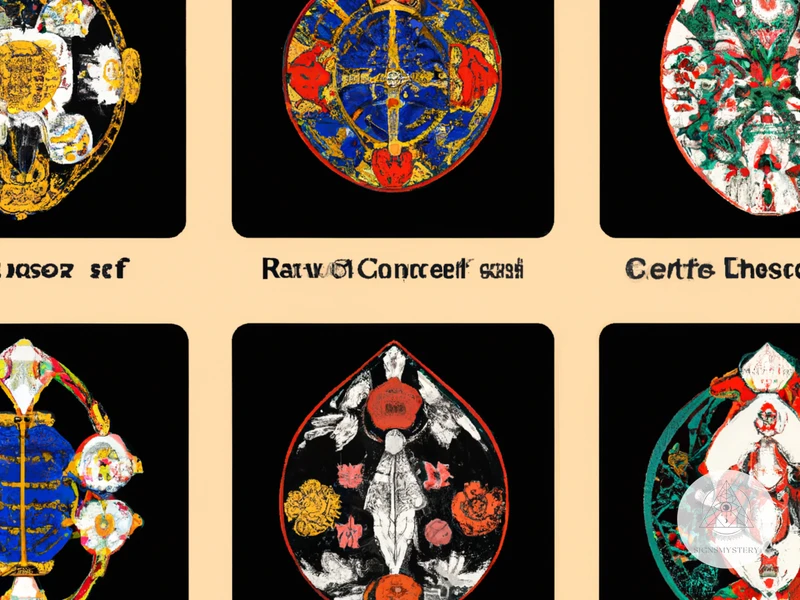
The Court Cards in tarot represent the people, personalities, and archetypes in our lives. These cards can often indicate actual individuals or aspects of our own personalities. The Court Cards are categorized into four suits: Page, Knight, Queen, and King. Each suit reflects a specific element and represents different characteristics. For instance, the Pages are associated with **youthfulness** and **potential** while the Kings represent **authority** and **power**. In a reading, the Court Cards can offer insight into the people involved in the situation at hand. They can indicate the qualities that need to be embraced or the areas that need to be improved. It is crucial to interpret the Court Cards in context with the rest of the spread for a more comprehensive understanding. To comprehend the Minor Arcana better, one must acknowledge the importance of each suit, including the Wands, Cups, Pentacles, and Swords.
The Pages: Youthfulness, Potential, and Energy
The Pages in the Minor Arcana are often associated with youthful energy, potential, and curiosity. They are represented by the element of Earth and are connected to the physical body and material world. The Pages can be seen as messengers, bringing new beginnings and fresh perspectives to a reading.
One of the most notable characteristics of the Pages is their sense of boundless energy and ambition. They are full of enthusiasm and curiosity, constantly searching for the next adventure or challenge to take on. When the Page of Wands appears in a reading, for example, it may indicate a desire to explore new horizons or take a bold risk towards a goal, making it an excellent card for those looking to embark on new ventures or projects.
At the same time, Pages can struggle with a lack of experience and maturity, leading them to make impulsive decisions or overlook important details. To the Page of Cups, this may mean being overly idealistic or emotionally driven when it comes to relationships or creative endeavors. However, when framed in a positive light, this youthful energy can also represent a fresh perspective or a willingness to try new things without fear of failure.
In terms of potential, Pages are seen as holding a great deal of promise and possibility in the areas of life represented by their suit. The Page of Pentacles, for example, may represent someone who is just starting out on a new career or financial endeavor, yet has the potential to grow and achieve great success. The Page of Swords, on the other hand, can represent someone who is highly intellectual and has the potential to achieve great things academically or through analytical thinking.
The Pages in the Minor Arcana represent a sense of youthful energy, potential, and curiosity. While they may lack experience and maturity, they make up for it with enthusiasm and an eagerness to explore new horizons. When interpreting Pages in a reading, it is important to keep in mind their potential and their tendency towards impulsivity, balancing these qualities in order to provide a well-rounded interpretation.
The Knights: Change, Progression, and Movement
In a tarot deck, the Knights represent change, progression, and movement. They are the action-takers of the Court Cards and often symbolize a journey or a quest towards a specific goal or destination.
Each Knight in the tarot deck represents a unique aspect of change and progression depending on their suit.
The Knight of Pentacles represents the steady and slow-moving progress towards material wealth and stability. They suggest that hard work and dedication will pay off in the long run and encourage us to stay the course.
The Knight of Swords brings swift and sudden change, often through challenges and conflicts. They symbolize the need to act quickly and assertively in order to overcome obstacles and move forward.
The Knight of Cups represents emotional growth and the need to pursue one’s dreams and passions. They encourage us to follow our hearts, no matter how unconventional or risky our desires may be.
The Knight of Wands symbolizes the energy and inspiration needed to pursue our goals and ambitions. They suggest that taking risks and embracing new opportunities will lead to growth and success.
When these Knights appear in a tarot reading, they often indicate a need to take action or make a change in order to progress towards our goals. However, it’s important to remember that each Knight has their own unique energy and approach to change, and it’s essential to consider their individual meanings in the context of the reading.
Interpretation of the Knights can be complex and nuanced, and it’s important to approach them with an open mind and a willingness to consider multiple perspectives. With practice and reflection, the Knights can offer valuable insights and guidance on our journey towards personal growth and fulfillment.
Internal Link: For a deeper understanding of the importance of the Minor Arcana in tarot, check out our article on the Importance of the Minor Arcana in Tarot.
The Queens: Nurturing, Emotional, and Intuitive
Queens in Tarot represent nurturing, emotions, and intuition. They are warm, compassionate, and empathetic individuals who are great at connecting with others. They possess an intuitive understanding of themselves and the world around them. Each of the four suits in Tarot has a corresponding Queen, but despite their differences in appearance and other attributes, they share common characteristics that unite them.
The Queen of Cups is linked to the emotional realm of Cups, and she embodies the qualities of nurturing, compassion, and empathy. She is a true empath, capable of feeling others’ emotions and understanding their experiences. This Queen is also associated with the element of water, which represents emotions, intuition, and sensitivity. When this card appears in a reading, it often signifies a call to embrace one’s emotions and express them freely.
The Queen of Pentacles, on the other hand, embodies the practical and grounded qualities of the Pentacles suit. She is nurturing in a physical sense, taking care of others through material and financial means. This Queen is often associated with abundance, prosperity, and fertility. When she appears in a spread, it may suggest a need to focus on domestic matters, home life, and financial security.
The Queen of Swords represents the mental realm of Swords, embodying qualities such as logic, reason, and critical thinking. She is known for her sharp mind, keen sense of observation, and ability to communicate and express herself clearly. This Queen represents strategic thinking and discernment, often serving as a mediator or counselor. When this card appears in a reading, it may suggest a need to approach a situation with an open mind and be willing to listen to both sides of an issue.
The Queen of Wands embodies the fiery and passionate qualities of the Wands suit, representing creativity, inspiration, and personal power. This Queen is a natural leader, inspiring those around her and encouraging them to pursue their passions. She represents the courage and determination needed to pursue one’s dreams, even in the face of adversity. When the Queen of Wands appears in a spread, it may suggest a need to tap into one’s creative potential and take a leap of faith towards achieving one’s goals.
The Queens in Tarot represent the nurturing and intuitive qualities that are often associated with femininity. Each Queen offers a unique perspective and approach to their corresponding suit, but all of them share a deep sense of compassion and understanding for those around them. If you want to deepen your understanding of Tarot, you may want to check out some resources on exploring the Fool card, or learn more about the meanings of the Empress and the Hanged Man in the Major Arcana. Additionally, you may be interested in understanding the significance of wands in the Minor Arcana.
The Kings: Authority, Power, and Control
The Kings in the minor arcana are the highest ranking court cards. They represent mature masculinity, authority, power, and control. They are associated with the element of fire, as well as the astrological signs of Aries, Leo, and Sagittarius.
Each of the four suits has a king, and each king has their own set of characteristics and meanings. Below is a breakdown of the four kings in the minor arcana:
| King | Suit | Element | Astrological Sign | Meaning |
|---|---|---|---|---|
| King of Pentacles | Pentacles | Earth | Taurus, Virgo, Capricorn | The King of Pentacles represents material wealth, financial stability, and a pragmatic approach to life. |
| King of Swords | Swords | Air | Gemini, Libra, Aquarius | The King of Swords represents intellect, logic, and clear communication. He is often associated with legal matters. |
| King of Cups | Cups | Water | Cancer, Scorpio, Pisces | The King of Cups represents emotional maturity, compassion, and intuition. He is often associated with matters of the heart. |
| King of Wands | Wands | Fire | Aries, Leo, Sagittarius | The King of Wands represents creativity, leadership, and a bold and charismatic personality. |
When the Kings show up in a reading, they often represent a person in the querent’s life who embodies the characteristics of that particular king. They could also represent the querent themselves, or a situation that requires the traits associated with that king.
It’s important to note that the Kings can have both positive and negative connotations. While they represent authority and control, they can also be domineering and stubborn. It’s up to the reader to interpret the cards in the context of the reading and the question at hand.
Internal link: To understand the beginnings of the Tarot journey, you can start by exploring the Fool card. If you want to learn about the meanings of other major arcana cards, check out our articles on the Empress, the Hanged Man, and the Tower. To learn more about the Wands suit, take a look at our article on Understanding the Wands in the Minor Arcana.
Interpreting the Court Cards in Your Readings
One of the most challenging aspects of reading the Tarot is interpreting the Court Cards. These cards represent people or personalities, and each one has its own unique set of characteristics and meanings. It’s important to pay attention to the Court Card’s suit, as well as its position in the spread, to gain a better understanding of its message. When interpreting the Pages, pay attention to their youthful energy and potential for growth. The Knights represent movement and change, while the Queens convey nurturing and intuitive energy. The Kings embody power and control. When interpreting these cards, pay attention to the message they convey and how they relate to the other cards in the spread. Don’t be afraid to trust your intuition when interpreting Court Cards, as they often contain important messages that can guide you on your path.
Understanding the Relationships Between Court Cards
Understanding the relationships between court cards is essential for interpreting them in your tarot readings accurately. Court cards, just like people, have unique personalities and qualities that can change depending on the situation and the other cards drawn in the spread.
One way to understand how court cards relate to each other is to view them as a family. The Pages can be seen as children, the Knights as young adults, the Queens as mothers, and the Kings as fathers. Each suit also has a distinct energy that can influence how the court cards interact with each other.
For example, in the suit of Pentacles, the court cards may represent a family-owned business or a tight-knit community centered around finances and material possessions. The Page of Pentacles could represent a young person just starting to learn about money and investments, while the King of Pentacles could represent a wealthy and successful business owner.
Another way to view the relationships between court cards is to consider their elemental correspondences. Pages are associated with Earth, Knights with Air, Queens with Water, and Kings with Fire. Each element has its own qualities that can affect the interpretation of the cards.
For instance, in the suit of Swords, the court cards may represent intellectual and communicative abilities. The Knight of Swords could represent quick thinking and decisive action, while the Queen of Swords could represent sharp wit and cutting words.
It’s also essential to pay attention to the placement of the court cards in your spread. For example, if a Knight card is placed next to a Page or Queen of the same suit, it may indicate that the younger or more emotional energy is being influenced by the more mature and rational energy of the Knight.
Additionally, pay attention to any reversed court cards in your spread. Reversed court cards can indicate a blocked or distorted expression of their qualities or an imbalance in their energy. For example, a reversed King of Cups may indicate emotional manipulation or an inability to cope with difficult emotions.
Understanding the relationships between court cards can add depth and nuance to
Subscribe to Our Newsletter
Sign up to receive the latest news and updates.
Reading Reversed Court Cards
Reading reversed court cards can add a deeper layer of meaning to your tarot readings. Reversed court cards can indicate a blockage or imbalance in the energy of the card, or a contradiction to the upright meaning. Here are some tips for reading reversed court cards:
- Consider the direction of the card: When you pull a reversed court card, consider whether the person depicted on the card is facing towards or away from the center of the card. A card that is facing towards the center may indicate a more inward-focused energy, while a card facing away from the center may indicate an outward-focused energy.
- Look at the surrounding cards: Pay attention to the cards surrounding the reversed court card. Do they support or contradict the energy of the reversed court card?
- Consider the element of the suit: Each suit corresponds to a different element: Pentacles to earth, Swords to air, Cups to water, and Wands to fire. Consider how the reversed energy of the court card relates to the element of the suit.
- Take note of the court card’s position: Pay attention to the position of the reversed court card. Is it in an important position, such as the overall theme or outcome card?
- Use your intuition: As with any tarot reading, trust your intuition when interpreting reversed court cards. Allow the imagery of the card to speak to you and guide your interpretation.
Remember that reversed court cards are not always negative. They can simply indicate a different perspective or energy than the upright meaning. By paying attention to the direction of the card, surrounding cards, suit element, position, and your intuition, you can gain a deeper understanding of the reversed court card’s significance in your tarot reading.
Combining Court Cards with Other Cards in Your Spreads
Combining court cards with other cards in your spreads is a crucial step to take when interpreting a tarot reading. Each court card has its unique personality and energy, and understanding how they interact with other cards can provide a comprehensive interpretation of your spread.
When combining court cards with other cards, the first thing to consider is the suit. Each suit has a specific element, and the court card’s personality will align with that element. For example, a Queen of Cups paired with the Ace of Cups suggests deep emotional connections or new beginnings in relationships. In contrast, a Queen of Swords combined with the same Ace could indicate a need for intellectual clarity and detachment.
Another crucial factor when combining court cards with other cards is the direction they face. If a court card faces away from another card, it may indicate that they are not in harmony or not working together. On the other hand, if they face towards each other, it can suggest a powerful connection between the energies of the two cards.
It is also important to consider the position of court cards in your spread. As they represent people or personalities, they are often placed in positions symbolizing the querent or other significators in the spread. Understanding the position of the court card can help provide insight into relationships, motivations, and behaviors.
When interpreting a spread that contains multiple court cards, consider their relationships with each other. Do they complement or clash with one another? For example, a King of Wands paired with a Queen of Swords could indicate a fiery and passionate relationship, but one fraught with arguments and power struggles.
Ultimately, the key to combining court cards with other cards in your spread is to focus on the energies represented by each card and how they interact with each other. Take time to reflect on the message that comes through, considering all aspects of the spread. By incorporating your intuition and knowledge of the tarot, you can develop a deeper connection with your cards and provide more insightful readings.
Tips for Working with Court Cards
Working with Court Cards can be challenging, but there are some tips that can help you navigate their meanings with ease. First, consider journaling and reflecting on your experiences with each Court Card. This can help you build a personal connection to each card and better understand its significance. Second, try using imagery and meditation to immerse yourself in the characteristics of each Court Card. This can deepen your understanding and intuition when interpreting them. Finally, learning from other readers and their interpretations can offer new perspectives and insights into the Court Cards. Utilize these tips to enhance your practice and confidently incorporate Court Cards into your readings.
Journaling and Reflecting on Court Cards
Journaling and reflecting on court cards is an effective way to deepen your understanding of their meanings and significance in tarot readings. Here are some tips to get started:
| 1. Choose a court card | Select a court card that you want to explore and learn more about. You can choose one randomly or intentionally pick a card that you feel drawn to. |
|---|---|
| 2. Write down your initial impressions | Take a few minutes to jot down your initial thoughts and feelings about the card. What stands out to you? What emotions does it evoke? |
| 3. Research the traditional meanings | Consult a tarot guidebook or reputable online resources to learn more about the traditional meanings and interpretations of the card. |
| 4. Consider the context of the card | Think about the role of the card within the reading. Is it a message of advice? A representation of a person or situation? |
| 5. Reflect on personal associations | Consider any personal associations or experiences that the card brings up for you. Does it remind you of someone in your life? A particular situation or challenge? |
| 6. Journal your insights | Write down any insights, revelations, or new understandings that arise as you reflect on the card. Use this as a space for freeform writing and exploration. |
| 7. Use your insights in readings | Take your new insights and understanding of the card into your tarot readings. Use them to inform your interpretation of the card in different contexts. |
Journaling and reflecting in this way can help deepen your connection to the court cards and enhance the accuracy and insightfulness of your readings. Give it a try and see what new understandings and revelations arise.
Using Imagery and Meditation to Connect with Court Cards
One of the most effective ways of understanding and connecting with court cards is through the use of imagery and meditation practices. Visualization can help bring court card archetypes to life, deepening your understanding of the characteristics and personalities of each card. Here are some techniques you can use to connect with your court card deck through meditation and visualization:
| Technique | Description |
| 1. Court Card Meditation | Take a few deep breaths to calm your mind and body. Shuffle your deck and select a court card that you would like to connect with. Look at the card and take notice of the colors, symbols, and expressions on the card. Close your eyes, and imagine yourself entering the card. Allow yourself to explore the environment and interact with the characters in the card. Observe their behaviors and listen to their words. When you are ready, slowly return to the present moment. |
| 2. Drawing Your Own Court Card | Using pencil and paper, draw your own version of a court card. Think about the character’s facial expressions, clothing, and surroundings. Once you have finished the drawing, sit with it and start to imagine the character in motion. Visualize the card coming to life, moving around, and interacting with the environment. |
| 3. Creating a Court Card Collage | Gather magazines, images or even fabric representing the different court card elements. Sort through and select images that remind you of the different court cards. Cut out the images and arrange them on a piece of board or paper, creating a collage. Visualize the images and let your intuition guide you to make connections between them. |
| 4. Guided Visualization | Find a guided visualization online or from a book. Follow the instructions to enter a relaxed state of mind. Listen to the voice of the guide as they lead you through the visualization using imagery and metaphors. Allow yourself to feel and experience the emotions and sensations suggested by the guide. Take as much time as you need to absorb the experience and slowly return to your daily life. |
Through these exercises, you can transcend the verbal and literal meanings of court cards and reach deeper levels of understanding and connection. By allowing yourself to interact with the archetypes of the court cards, you can enrich your readings and develop your own personal relationship with each card. Experiment with these techniques and see which works best for you. Remember to approach your practice with an open mind and trust your intuition.
Learning from Other Readers and Their Interpretations
As with any aspect of tarot reading, there is always room for learning and growing. Learning from other readers and their interpretations is a valuable way to expand your understanding of court cards and their meanings.
Joining Tarot Communities: One way to connect with other readers is by joining tarot communities or groups online or in person. These groups can provide a wealth of knowledge and offer different perspectives on how to interpret the court cards. You can also ask for feedback on your own interpretations and engage in discussions about different spreads or techniques.
Reading Tarot Books: Another helpful resource is tarot books written by experienced readers. These books often provide in-depth explanations and examples of how to interpret the court cards in various situations. You can also gain insight into other readers’ interpretations and techniques through their written work.
Watching Tarot Videos: With the growing popularity of YouTube, there are now many tarot readers who share their insights and interpretations through videos. Watching tarot videos can give you a better understanding of how other readers approach the court cards and can also provide inspiration for your own readings.
Attending Tarot Workshops: Finally, attending tarot workshops or classes can be a great way to learn from experienced readers in a more interactive setting. You can ask questions, practice techniques, and receive feedback on your interpretations.
Learning from other readers and their interpretations can deepen your understanding of the court cards and improve your tarot reading skills. Keep an open mind and be willing to try new techniques and approaches as you continue to grow as a reader.
Conclusion: Embracing the Court Cards in Your Practice
Congratulations! You have made it to the end of our guide to understanding the role of court cards in the minor arcana. Now that you have learned about each of the court cards and their significance, as well as how to interpret them in your readings, it is time to put all of this knowledge into practice.
Embracing the court cards in your practice can give your readings a new level of depth and insight. They offer a nuanced understanding of the energies and personalities at play in a given situation, and can provide clarity and guidance on the best course of action.
As you begin to work with the court cards, keep in mind that each reader may interpret them differently, based on their own experiences and perspectives. Don’t be afraid to experiment with your own approach and find what works best for you.
To help you on your journey, here are a few tips for making the most of your court card readings:
Tip 1: Practice, Practice, Practice
Like any skill, interpreting court cards takes practice. Pull a card each day and reflect on its meaning, or incorporate them into your regular readings to get a feel for their nuances. The more you work with them, the more comfortable and confident you will become.
Tip 2: Compare and Contrast
When you encounter a court card in a reading, take a moment to compare and contrast it with the other cards in the spread. What relationships do you see? How do these energies interact? Paying attention to these details can help you better understand the readings as a whole.
Tip 3: Trust your Intuition
While it is important to have a solid understanding of each court card and their meanings, don’t forget to trust your intuition. If a card speaks to you in a certain way, don’t be afraid to follow that inner guidance.
Tip 4: Seek Inspiration
If you ever find yourself stuck or in need of inspiration, turn to other readers for guidance. There are countless interpretations of each court card out there, and learning from others can help you expand your own understanding and deepen your practice.
So go forth and embrace the court cards in your practice! With time, patience, and a willingness to learn, they can become powerful tools for personal growth and insight.
Frequently Asked Questions
What are Court Cards in Tarot?
Court cards are a subset of the Minor Arcana in Tarot decks, consisting of 16 cards divided into four suits. They represent personality archetypes and are often used to indicate people in a Tarot reading.
What makes the Court Cards significant in a Tarot reading?
Court cards can provide insight into the people involved in a situation or the qualities needed to approach a situation. They can also represent different aspects of the querent’s personality or the people they might encounter.
How should the four suits of the Minor Arcana be interpreted?
The four suits represent different aspects of life: Pentacles for material concerns, Swords for intellectual and mental matters, Cups for emotions and relationships, and Wands for creativity and passion.
What are the different meanings of the Pages in Court Cards?
Pages symbolize youthful energy, exploration, and potential. They can suggest a new beginning or a time to learn and develop a skill or idea.
What do the Knights represent in Court Cards?
The Knights represent change, progression, and movement. They can indicate a new direction in life, a swift action, or a need for courage and determination.
What are the meanings of the Queens in Court Cards?
Queens represent nurturing, emotional intelligence, and intuition. They can indicate support, positivity, and guidance, or a need to connect with one’s own emotions and inner wisdom.
What do the Kings symbolize in Court Cards?
Kings represent authority, power, and control. They can indicate leadership, confidence, and a need to take charge of a situation or assert oneself.
Why is it important to understand relationships between Court Cards?
Interpreting the relationships between Court Cards can give more context to a reading and suggest how different personalities or qualities might interact or influence each other.
What should be considered when reading reversed Court Cards?
Reversed Court Cards can indicate a block or imbalance in the qualities represented by the card, or suggest a need to focus more on inner work or personal growth related to that archetype.
How can journaling and meditation help in connecting with Court Cards?
Journaling and reflecting on Court Cards can help deepen one’s understanding and relationship with them over time. Using meditation or visualization techniques can also provide insights and help one connect with the archetypes in a personal way.



